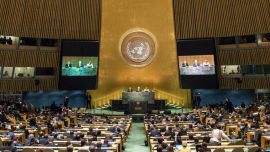Before being named as head of the Catholic Church, Jorge Bergoglio served as archbishop of Buenos Aires, the city of his birth, with which he always maintained fraternal ties.
His legacy lives on in the neighbourhood of Flores, at his beloved San Lorenzo football club, and in the shantytowns he regularly visited.
Flores: cradle and religion
References to Pope Francis abound at the Basilica of San José de Flores, located in the centre of the Buenos Aires neighbourhood of Flores, where Bergoglio grew up in a modest family of five children.
“In this confessional, on September 21, 1953, a young Jorge Mario Bergoglio heeded God's call to the priesthood,” reads a golden plaque set above the carved wooden kneeler.
“His apostolic life began here,” reflects Father Martín Rebollo Paz, the basilica’s vicar, with pride.
A sign of his bond with the Basilica and the neighbourhood could be seen in the image of a sleeping Saint Joseph he sent on the tenth anniversary of his papacy.
“He holds the basilica very close to his heart. He gifted us this sleeping Saint Joseph, which was flown here by plane. It caused a stir across the entire community,” the priest said in an interview.
Locals remember him as just another neighbour. “He used to come out and sweep the pavement if it was dirty!” said 77-year-old Cristina Marcheschi.
She said that when she heard of the Pope’s death on Monday morning, the sadness was overwhelming. “I felt like dying,” she admits.
“How humble he was – he was a man, not a Pope,” she adds.
“Flores is like a romantic, Catholic Italian village,” said Roberto D’Anna, the president of the Museo Barrio de Flores (“Flores Neighbourhood Museum”), which has memorabilia linked to Francis.
The museum’s prize possession is a handwritten letter the Pope to mark its opening in 2018.
“Flores is the neighbourhood where I was born and lived until I entered the seminary. With a bit of petulance, I can say it’s my neighbourhood, my roots,” reads the note.
Love of San Lorenzo
Nearby are the Basílica María Auxiliadora y San Carlos, where the late pontiff was baptised; the house where he was born; and another where he spent his early childhood.
Also nearby are his primary and secondary schools, both public, and the Catholic institute Nuestra Señora de la Misericordia, where he attended nursery school and where his sisters were also educated.
On the steps of the inner courtyard, young Jorge learned his multiplication tables, repeating them as he went up and down the stairs.
It was also there that Sister Dolores prepared him for his first communion, a rite he fulfilled in 1946 in the school chapel, where – once ordained as a priest – he would later celebrate Mass for the students.
As archbishop, Bergoglio always maintained a close bond with the school, where he used to share gnocchi lunches with the nuns on Sundays in the kitchen.
Further south, in Bajo Flores, stands the stadium of San Lorenzo football club, which was founded by a priest in 1908. Pope Francis is its most famous fan.
Every April 1, the club’s anniversary, Francis would celebrate Mass himself in the chapel at the club’s sports ground. At the Vatican, several shirts from his beloved San Lorenzo were displayed in a glass case.
It is said that the young Bergoglio fell in love with the team in 1946, when the club won the championship with a string of memorable victories over Boca Juniors, River Plate, Racing Club and other giants of the domestic game.
Archbishop of the marginalised
The marginalised villas, or shantytowns, of Buenos Aires were another place the Argentine frequented.
“We saw continuity. We didn’t see a difference between Bergoglio the Pope and Bergoglio the bishop. We already knew his simplicity, his commitment to the poor and his social sensitivity,” said Father Lorenzo ‘Padre Toto’ de Vedia, a parish priest at the Chapel of the Virgin of Caacupé in Villa 21-24.
The curas villeros — priests who serve in the shantytowns — emerged in 1969, inspired by the Movimiento de Sacerdotes para el Tercer Mundo (Movement of Priests for the Third World, MSTM). Historically marginalised within the Church hierarchy, they were embraced by Bergoglio, who built bridges with them.
As archbishop, he visited the shantytown “at least five or six times a year,” and every December 8, he led the crowd that gathered at the parish doors for the feast of the virgin,” he recalled in a 2023 interview.
Father Guillermo Torres, who spent 22 years living in Villa 31, said that Bergoglio “ensured that in every working-class neighbourhood and emergency settlement there were priests to support the people.”
“He always said it was a poor Church for the poor.”
related news
by Sonia Avalos, AFP

























Comments